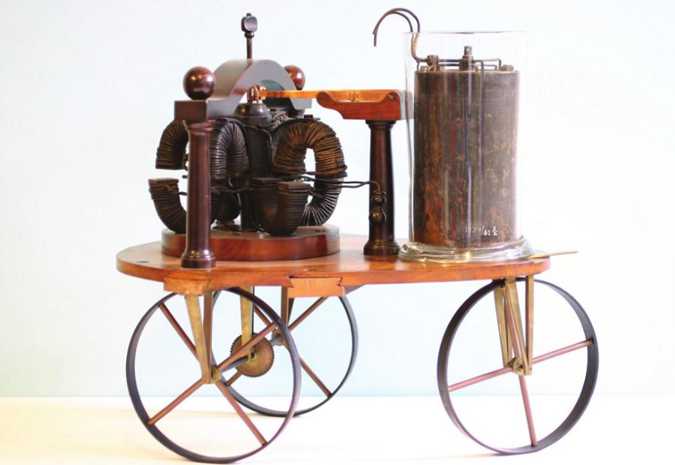As Davidson was beavering away on electric trains, another Scotsman was examining the possibilities of an electric horseless carriage. Little is known about Robert Anderson’s invention – sadly the details of his vehicle have been lost – but sometime between 1832 and 1839 he designed, built and tested a battery-powered horseless carriage.
Unfortunately for him, Anderson had no alternative but to use non-rechargeable cells as the lead-acid rechargeable battery wasn’t invented until 1859, thus making his carriage nothing more than an interesting oddity and the smallest of footnotes in history, rather than a ground-breaking invention. Despite this, Anderson can still be said to be one of the pioneers of the electric car. The other was a Dutchman.
Sibrandus Stratingh was a Dutch chemistry professor and keen inventor with a yen for speed. He was convinced technology would make the horse-and-carriage redundant. Stratingh and his friend, German instrument maker Christopher Becker, were at the forefront of steam power development.
On 25 March 1834, The Provincial Groninger Courant, a newspaper published in the Dutch province of Groningen, reported:
In the early hours of this morning, 22 March, the first test journey was made by messrs Stratingh and Becker on their steam vehicle, which made a journey through the city’s undulating and curving streets with a positive result. The designers were so happy with the test that they feel that some small improvements will enable the vehicle to not only travel over new stone and rock roads, but also the bumpier cobbled streets, without problem…
On 8 September, the papers carried a report of a trip the friends made outside the town, passing through several villages and ‘moving with the speed of several running horses’ for more than four hours.

Although Stratingh’s invention attracted crowds wherever it went, the professor was unhappy with it. The carriage was uncomfortable, smoky and noisy. The solution, as Stratingh saw it, was to switch from steam power to electricity.
In 1835, Professor Stratingh gave a lecture to the Royal Physics Society, in Groningen, entitled: ‘Electromagnetic moving force and the use of this to an electromagnetic carriage…’. The idea for a small-scale electric cart came to him after reading reports of the work of Moritz von Jacobi, who had designed an electromagnetic motor at the Academy of Sciences in St Petersburg, Russia.
What they came up with was a very basic wooden platform to carry a galvanic battery, consisting of two plates, one zinc and one copper, rolled together and divided by wooden rods sitting in a porcelain jar filled with dilute acid. This cocktail was precariously mounted on the front to provide the current. Professor Stratingh described the vehicle as his ‘electric motor’.
The carriage weighed about 6.6lb (3kg) and could drive for about fifteen minutes loaded with half its own weight before the current was exhausted. Professor Stratingh made several electric horseless carriages and a number still survive. Most of them are on display at the Museum Boerhaave, in Leiden, the Netherlands, and can be said to be the oldest electric vehicles still in existence.
The ultimate development of the professor’s ideas had eight magnets, instead of four, so that in its positive position there are twelve poles on twelve poles working on each other to give maximum power. In 1934, this vehicle was donated to the Museum of the University of Groningen. Today, it is one of the museum’s most important and valuable exhibits.
Professor Stratingh was a leading advocate of electric power. At his urging Becker began building larger magnets and Stratingh stated confidently that an electric carriage would easily outrun a steam-powered rival. Electric vehicles were simpler, lighter, carried no heavy fuels and offered no danger of explosion or fire.
As well as his carriages, Professor Stratingh also built a model electric boat, which he sailed in the pond near his home. Sadly, his experiments in electric propulsion were curtailed by ill-health and he died in February 1841. Nevertheless, Professor Stratingh had demonstrated that electricity was a viable means of vehicle propulsion – an idea that was enthusiastically taken up by others.